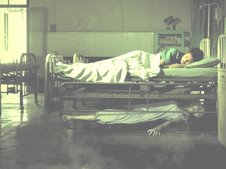Friday, April 27, 2012
Paraphilia
From Wikipedia, the free encyclopedia
Jump to: navigation, search
Paraphilia
Classification and external resources
MeSH D010262
Paraphilia (in Greek para pa?? = beside and -philia f???a = friendship, meaning love) is a biomedical term used to describe sexual arousal to objects, situations, or individuals that are not part of normative stimulation and that may cause distress or serious problems for the paraphiliac or persons associated with him or her. A paraphilia involves sexual arousal and gratification towards sexual behavior that is atypical or extreme.[1] The term was coined by Wilhelm Stekel in the 1920s.[2] Sexologist John Money later popularized the term as a nonpejorative designation for unusual sexual interests.[3][4][5][6] He described paraphilia as "a sexuoerotic embellishment of, or alternative to the official, ideological norm."[7]
In the late 19th century, psychologists and psychiatrists started to categorize various paraphilias as they wanted a more descriptive system than the legal and religious constructs of sodomy[8] and perversion.[9] Before the introduction of the term paraphilia in the DSM-III (1980), the term sexual deviation was used to refer to paraphilias in the first two editions of the manual.[10] In 1981 an article published in American Journal of Psychiatry described paraphilia as "recurrent, intense sexually arousing fantasies, sexual urges, or behaviors generally involving:[11]
1. Non-human objects
2. The suffering or humiliation of oneself or one's partner
3. Children
4. Non-consenting persons[12]
Until 1973, homosexuality was included in this list.[13][14][15][16]
The view of paraphilias as disorders is not universal. Some groups seeking greater understanding and acceptance of sexual diversity have lobbied for changes to the legal and medical status of unusual sexual interests and practices. Charles Allen Moser, a physician and advocate for sexual minorities, has argued that the diagnoses should be eliminated from diagnostic manuals.[17] Psychiatrist Glen Gabbard writes that despite efforts by Stekel and Money, "the term paraphilia remains pejorative in most circumstances."[18]
In the current version of the DSM (DSM-IV-TR), a paraphilia is not diagnosable as a psychiatric disorder unless it causes distress to the individual or harm to others.[1] The DSM-5 draft adds a terminology distinction between the two cases, stating that "paraphilias are not ipso facto psychiatric disorders", and defining paraphilic disorder as "a paraphilia that causes distress or impairment to the individual or harm to others".[19] This will make a clear distinction between a healthy person with a non-normative sexual behavior and a person with a psychopathological non-normative sexual behavior.
Contents
[hide]
* 1 General concerns
o 1.1 Terminological
o 1.2 Classification
o 1.3 Homosexuality
* 2 Clinical views
o 2.1 Neurodevelopmental correlates in men
o 2.2 Classifications and theories
o 2.3 Diagnostic and Statistical Manual of Mental Disorders
+ 2.3.1 DSM-I and DSM-II
+ 2.3.2 DSM-III through DSM-IV-TR
+ 2.3.3 DSM-5 draft
o 2.4 Intensity and specificity
o 2.5 Drug treatments
+ 2.5.1 Hormonal
+ 2.5.2 Psychoactive
* 3 United States legal cases
* 4 See also
* 5 References
* 6 External links
[edit] General concerns
[edit] Terminological
Paraphilial psychopathology is not the same as psychologically normative adult human sexual behaviors, sexual fantasy, and sex play. These terms have been used in interchangeable ways which can allow for cognitive and clinical diagnostic misjudgment to occur. Consensual adult activities and adult entertainment that may involve some aspects of sexual roleplay, novel, superficial, or trivial aspects of sexual fetishism, or may incorporate the use of sex toys are not necessarily paraphilic.[12]
[edit] Classification
It is not known how many different kinds of paraphilias exist; one source lists as many as 549 paraphilias.[20] Because so many paraphilias exist, one needs to classify them in an orderly and meaningful way. It has long been argued that the Diagnostic and Statistical Manual of Mental Disorders (DSM) system of classification makes unjustified categorical distinctions between disorders, and between normal and abnormal. Although the DSM-5 may move away from this categorical approach in some limited areas, some argue that a fully dimensional, spectrum or complaint-oriented approach would better reflect the evidence.[21][22]
There is scientific and political controversy regarding the continued inclusion of sex-related diagnoses such as the paraphilias in the DSM.[23]
[edit] Homosexuality
Homosexuality was at one time categorized as a form of paraphilia.[14] Sigmund Freud and his proponents considered homosexuality and paraphilias to be forms of psychosexual infantilism. In a 1951 symposium discussing psychiatrist Benjamin Karpman's paper "The Sexual Psychopath,"[24] psychiatrist Emil Gutheil said, "Looking back upon my own experience with so-called psychopaths, I find one characteristic they all have in common, and that is their infantilism. Take the man who is a homosexual. In his paraphilia he regresses to the time he was bisexual, that is, to his infantile level."[24]
By the mid-20th century, mental health practitioners began formalizing "deviant sexuality" classifications into categories. Researcher Anil Aggrawal writes that the 1952 first edition of the Diagnostic and Statistical Manual of Mental Disorders (DSM) specified "the type of the pathological behavior, such as homosexuality, transvestism, pedophilia, fetishism, and sexual sadism, including rape, sexual assault, mutilation)."[25] Originally coded as 000-x63, homosexuality was the top of the classification list (Code 302.0) until the American Psychiatric Association removed homosexuality from the DSM in 1973. Other organizations followed suit, including the American Psychological Association in 1975, and the National Association of Social Workers.[26] Martin Kafka writes, "Sexual disorders once considered paraphilias (e.g., homosexuality) are now regarded as variants of normal sexuality."[16]
A 2012 literature study comparing homosexuality with paraphilias confirmed that homosexuality was sufficiently dissimilar from the paraphilias as to be considered an unrelated construct.[27]
[edit] Clinical views
Unbalanced scales.svg
An editor has expressed a concern that this article lends undue weight to certain ideas, incidents, controversies or matters relative to the article subject as a whole. Please help to create a more balanced presentation. Discuss and resolve this issue before removing this message. (October 2010)
[edit] Neurodevelopmental correlates in men
The causes of paraphilic sexual preferences in men are unclear, although a growing body of research points to a possible prenatal neurodevelopmental correlation. A 2008 study analyzing the sexual fantasies of 200 heterosexual men by using the Wilson Sex Fantasy Questionnaire exam, determined that males with a pronounced degree of fetish interest had a greater number of older brothers, a high 2D:4D digit ratio (which would indicate excessive prenatal estrogen exposure), and an elevated probability of being left-handed, suggesting that disturbed hemispheric brain lateralization may play a role in deviant attractions.[28]
[edit] Classifications and theories
Albert Eulenburg (1914) noted a commonality across the paraphilias, using the terminology of his time, "All the forms of sexual perversion...have one thing in common: their roots reach down into the matrix of natural and normal sex life; there they are somehow closely connected with the feelings and expressions of our physiological erotism. They are...hyperbolic intensifications, distortions, monstrous fruits of certain partial and secondary expressions of this erotism which is considered 'normal' or at least within the limits of healthy sex feeling."[29]
The clinical literature contains reports of many paraphilias, only some of which receive their own entries in the diagnostic taxonomies of the American Psychiatric Association or the World Health Organization.[30][31] There is disagreement regarding which sexual interests should be deemed paraphilic disorders versus normal variants of sexual interest. For example, as of May 2000, per DSM-IV-TR, "Because some cases of Sexual Sadism may not involve harm to a victim (e.g., inflicting humiliation on a consenting partner), the wording for sexual sadism involves a hybrid of the DSM-III-R and DSM-IV wording (i.e., “the person has acted on these urges with a non-consenting person, or the urges, sexual fantasies, or behaviors cause marked distress or interpersonal difficulty”)".[32]
[edit] Diagnostic and Statistical Manual of Mental Disorders
[edit] DSM-I and DSM-II
In American psychiatry, prior to the publication of the DSM-I, paraphilias were classified as cases of "psychopathic personality with pathologic sexuality". The DSM-I (1952) included sexual deviation as a personality disorder of sociopathic subtype. The only diagnostic guidance was that sexual deviation should have been "reserved for deviant sexuality which [was] not symptomatic of more extensive syndromes, such as schizophrenic or obsessional reactions". The specifics of the disorder were to be provided by the clinician as a "supplementary term" to the sexual deviation diagnosis; examples of this supplementary term provided in the DSM-I included homosexuality, transvestism, pedophilia, fetishism, and sexual sadism, including rape. There were no restrictions in the DSM-I on what this supplementary term could be.[33]
The DSM-II (1968) continued to use the term "sexual deviations", but no longer ascribed them under personality disorders, but rather them alongside them in a broad category titled "personality disorders and certain other nonpsychotic mental disorders". The types of sexual deviations listed in the DSM-II were: sexual orientation disturbance (homosexuality), fetishism, pedophilia, transvestitism (sic), exhibitionism, voyeurism, sadism, masochism, and "other sexual deviation". No definition or examples were provided for "other sexual deviation", but the general category of sexual deviation was meant to describe the sexual preference of individuals that was "directed primarily toward objects other than people of opposite sex, toward sexual acts not usually associated with coitus, or toward coitus performed under bizarre circumstances, as in necrophilia, pedophilia, sexual sadism, and fetishism."[34] Except for the removal of homosexuality from the DSM-III onwards, this definition provided a general standard that has guided specific definitions of paraphilias in subsequent DSM editions, up to DSM-IV-TR.[35]
[edit] DSM-III through DSM-IV-TR
The term "paraphilia" was introduced in the DSM-III (1980) as a subset of the new category of "psychosexual disorders". The types of paraphlias listed were: fetishism, transvestism, zoophilia, pedophilia, exhibitionism, voyeurism, sexual masochism, sexual sadism, and "atypical paraphilia". The DSM-III-R (1987) renamed the broad category to sexual disorders, renamed atypical paraphilia to paraphilia NOS (not otherwise specified), finessed transvestism as transvestic fetishism, added frotteurism, and removed zoophilia, relegating it to the NOS category. It also provided seven nonexhaustive examples of NOS paraphilias, which besides zoophilia included telephone scatologia, necrophilia, partialism, coprophilia, klismaphilia, and urophilia.[36]
The DSM-IV (1994) retained the sexual disorders classification for paraphlias, but added an even broader category, "sexual and gender identity disorders", which includes them. The DSM-IV retained the same types of paraphilias listed in DSM-III-R, including the NOS examples, but introduced some changes to the definitions of some specific types.[35]
Paraphilias are defined by DSM-IV-TR as sexual disorders characterized by "recurrent, intense sexually arousing fantasies, sexual urges or behaviors generally involving (1) nonhuman objects, (2) the suffering or humiliation of oneself or one's partner, or (3) children or other nonconsenting persons that occur over a period of 6 months" (Criterion A), which "cause clinically significant distress or impairment in social, occupational, or other important areas of functioning" (Criterion B). DSM-IV-TR describes 8 specific disorders of this type (exhibitionism, fetishism, frotteurism, pedophilia, sexual masochism, sexual sadism, voyeurism, and transvestic fetishism) along with a ninth residual category, paraphilia not otherwise specified (NOS).[37] Criterion B differs for exhibitionism, frotteurism, and pedophilia to include acting on these urges, and for sadism, acting on these urges with a nonconsenting person.[12]
Some paraphilias may interfere with the capacity for sexual activity with consenting adult partners.[12] According to the DSM, "Paraphilias are almost never diagnosed in females,"[12] but some case studies of females with paraphilias have been published.[38]
The DSM provides clinical criteria for these paraphilias:
* Exhibitionism: the recurrent urge or behavior to expose one's genitals to an unsuspecting person, or to perform sexual acts that can be watched by others.
* Fetishism: the use of inanimate objects to gain sexual excitement. Partialism refers to fetishes specifically involving nonsexual parts of the body.
* Frotteurism: recurrent urges of behavior of touching or rubbing against a nonconsenting person.
* Pedophilia: strong sexual attraction to prepubescent children.[39]
* Sexual Masochism: the recurrent urge or behavior of wanting to be humiliated, beaten, bound, or otherwise made to suffer for sexual pleasure.
* Sexual Sadism: the recurrent urge or behavior involving acts in which the pain or humiliation of a person is sexually exciting.
* Transvestic fetishism: arousal from wearing "clothing associated with members of the opposite sex."[12][40]
* Voyeurism: the recurrent urge or behavior to observe an unsuspecting person who is naked, disrobing, or engaging in sexual activities, or who is engaging in activities usually considered to be of a private nature.[41][42]
Under Paraphilia NOS, the DSM mentions telephone scatalogia (obscene phone calls), necrophilia (corpses), partialism (exclusive focus on one part of the body), zoophilia (animals), coprophilia (feces), klismaphilia (enemas), urophilia (urine), emetophilia (vomit). The DSM's Paraphilia NOS is equivalent to the ICD-9's Sexual Disorder NOS.
Sexual arousal in association with objects that were designed for sexual purposes is not diagnosable in DSM-IV (DSM, p. 570).[12]
[edit] DSM-5 draft
The DSM-5 Paraphilias Subworkgroup reached a "consensus that paraphilias are not ipso facto psychiatric disorders", and proposed "that the DSM-V make a distinction between paraphilias and paraphilic disorders. A paraphilia by itself would not automatically justify or require psychiatric intervention. A paraphilic disorder is a paraphilia that causes distress or impairment to the individual or harm to others. One would ascertain a paraphilia (according to the nature of the urges, fantasies, or behaviors) but diagnose a paraphilic disorder (on the basis of distress and impairment). In this conception, having a paraphilia would be a necessary but not a sufficient condition for having a paraphilic disorder." The 'Rationale' page of any paraphilia in the electronic DSM-5 draft continues: "This approach leaves intact the distinction between normative and non-normative sexual behavior, which could be important to researchers, but without automatically labeling non-normative sexual behavior as psychopathological. It also eliminates certain logical absurdities in the DSM-IV-TR. In that version, for example, a man cannot be classified as a transvestite—however much he cross-dresses and however sexually exciting that is to him—unless he is unhappy about this activity or impaired by it. This change in viewpoint would be reflected in the diagnostic criteria sets by the addition of the word “Disorder” to all the paraphilias. Thus, Sexual Sadism would become Sexual Sadism Disorder; Sexual Masochism would become Sexual Masochism Disorder, and so on."[19]
Bioethics professor Alice Dreger interpreted these changes as "a subtle way of saying sexual kinks are basically okay – so okay, the sub-work group doesn’t actually bother to define paraphilia. But a paraphilic disorder is defined: that’s when an atypical sexual interest causes distress or impairment to the individual or harm to others." Interviewed by Dreger, Ray Blanchard, the Chair of the Paraphilias Sub-Work Group, explained: "We tried to go as far as we could in depathologizing mild and harmless paraphilias, while recognizing that severe paraphilias that distress or impair people or cause them to do harm to others are validly regarded as disorders."[43]
Charles Allen Moser pointed out that this change is not really substantive as DSM-IV already acknowledged a difference between paraphilias and non-pathological but unusual sexual interests, a distinction that is virtually identical to what is being proposed for DSM-5, and it is a distinction that, in practice, has often been ignored.[44] Linguist A. C. Hinderliter argued that "Including some sexual interests—but not others—in the DSM creates a fundamental asymmetry and communicates a negative value judgment against the sexual interests included," and leaves the paraphilias in a situation similar to ego-dystonic homosexuality, which was removed from the DSM because it did not meet the DSM's definition of mental disorder.[45]
Historian and philosopher of science Patrick Singy claims that the DSM-5 is about to drastically loosen the criteria for paraphilias and to make them directly dependent on cultural values. The DSM-5 will then be closer to the DSM-I and DSM-II than to their successors, which all were at least trying to separate the concept of "mental disorder" from cultural norms, and which made "harm" or "distress" a necessary condition for having a mental disorder.[46]
[edit] Intensity and specificity
Clinicians distinguish between optional, preferred and exclusive paraphilias,[12] though the terminology is not completely standardized. An "optional" paraphilia is an alternative route to sexual arousal. For example, a man with otherwise unremarkable sexual interests might sometimes seek or enhance sexual arousal by wearing women's underwear. In preferred paraphilias, a person prefers the paraphilia to conventional sexual activities, but also engages in conventional sexual activities. For example, a man might prefer to wear women's underwear during sexual activity, whenever possible. In exclusive paraphilias, a person is unable to become sexually aroused in the absence of the paraphilia.[citation needed]
The literature includes single-case studies of exceedingly rare and idiosyncratic paraphilias. These include an adolescent male who had a strong fetishistic interest in the exhaust pipes of cars, a young man with a similar interest in a specific type of car, and a man who had a paraphilic interest in sneezing (both his own and the sneezing of others).[47][48] See also List of paraphilias.
[edit] Drug treatments
The treatment of paraphilias and related disorders has been challenging for patients and clinicians. In the past, surgical castration was advocated as a therapy for men with pedophilia, but has been abandoned for the time being because most governments consider it a cruel punishment where the express willingness and consent of the patient is not objectively indicated. Psychotherapy, self-help groups, and pharmacotherapy (including anti-androgen hormone therapy sometimes referred to as "chemical castration") have all been used. Other drug treatments for these disorders do exist, however.[49]
[edit] Hormonal
Antiandrogenic drugs such as medroxyprogesterone (also known as the long-acting contraceptive Depo Provera) have been widely used as therapy in these men to reduce sex drive. However, their efficacy is limited and they have many side effects, including breast growth, headaches, weight gain, and reduction in bone density. Even if compliance is good, only 60 to 80 percent of men benefit from this type of drug. Long-acting gonadotropin-releasing hormones, such as Triptorelin (Trelstar) which reduces the release of gonadotropin hormones, are also used. This drug is a synthetic hormone which may also lead to reduced sex drive.[49]
[edit] Psychoactive
Psychostimulants have been used recently to augment the effects of serotonergic drugs in paraphiliacs. In theory, the prescription of a psychostimulant without pretreatment with an SSRI might further disinhibit sexual behavior, but when taken together, the psychostimulant may actually reduce impulsive tendencies. Methylphenidate (Ritalin) is an amphetamine-like stimulant used primarily to manage the symptoms of attention deficit hyperactivity disorder (ADHD). Recent studies imply that methylphenidate may also act on serotonergic systems; this may be important in explaining the paradoxical calming effect of stimulants on ADHD patients. Amphetamine is also used medically as an adjunct to antidepressants in refractory cases of depression.[49]
[edit] United States legal cases
In the United States, following a series of landmark cases in the Supreme Court of the United States, persons diagnosed with paraphilias and a history of anti-social behavior, particularly pedophilia (Kansas v. Hendricks, 1997) and exhibitionism (Kansas v. Crane, 2002), can be held indefinitely in civil confinement under various state legislation generically known as Sexually violent predator laws[50][51] and the federal Adam Walsh Act (United States v. Comstock, 2010).[52][53]
Subscribe to:
Post Comments (Atom)







No comments:
Post a Comment